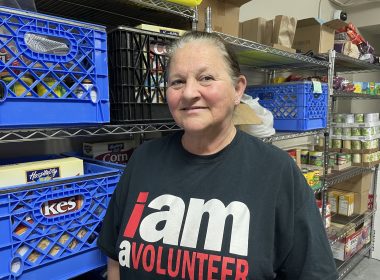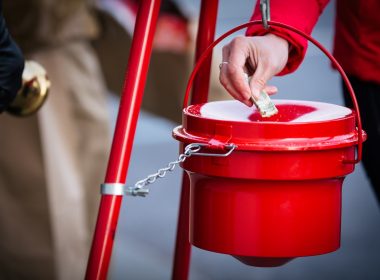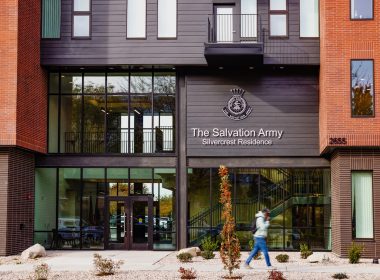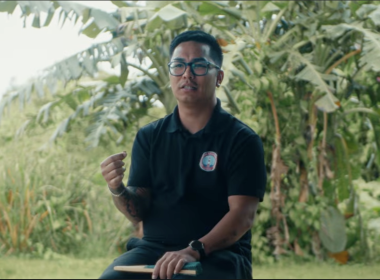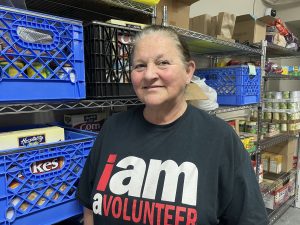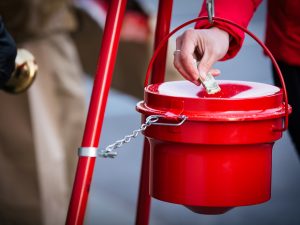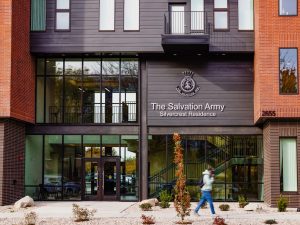Army works in New Orleans two years after Katrina
by Jeff Curnow –
Brass group from Southern California Division, led by Divisional Music Director Kevin Larsson, plays for workers at Habitat for Humanity site in New Orleans.
Jeff Curnow, New Frontier contributing editor, recently returned from a musical mission trip to New Orleans. In this article he gives an overview of The Salvation Army’s recovery work there, along with general impressions from the trip.
During 2005, Hurricanes Katrina, Rita, and Wilma spurred The Salvation Army’s largest natural disaster response in its history in the U.S. The Army received more than $394 million to assist in the effort.
Following an initial response phase that reached more than 1.7 million people, The Salvation Army continues today to be active in the recovery process.
Much remains to be done. The widespread flight of residents, many who have not returned—and probably will not—gives the town an eerie air of emptiness. In many of the areas that “weren’t hardest hit,” up to one in every four or five houses is abandoned. In areas like the city’s Ninth Ward, underwater for weeks, streets leading nowhere in empty fields mark all that is left of what was the poorest part of town.
Encouragement from California
From August 10-12, 2007, the Southern California Division sent a musical mission team to New Orleans to perform in different open air locations around the city, spread the Army’s gospel message and encourage attendance at the New Orleans Corps.
For the team—none of whom had seen the damage in person—the extent of it was overwhelming.
On Jackson Square, in the city’s famed French Quarter, street musicians have returned and are eking out a living. While the joyful sound of Dixieland still echoes through the streets, singer Wil Kennedy, in just a few lines of song, describes what many here feel two years after Katrina battered the city:
Yeah I’ve heard about City Park
They’ve done a fine job on the Dome
But what about the Ninth Ward?
Don’t the poor deserve a home?
A return to normal
Amid the frustration, a sense of normalcy is beginning to return. The Salvation Army Center of Hope— the same building where more than 200 people were sheltered from Katrina for more than two weeks—has housed volunteer workers for the past two years. This month the center will return to its former role as a homeless shelter.
Said Shelter Manager Ron Hall, “It’s been a terrible time for those, like the homeless, that the Army has always helped. Most of our facilities were damaged by the storm as well, and those that could be repaired quickly have been used in the recovery efforts. Our goal is to get shelters, thrift stores and much of the regular social service activities in the city restored to their normal functions by October 1.”
An eight-person pastoral ministries team follows-up with each family that the Army has helped. Majors Mills, who have stayed on in New Orleans after retirement say, “In our careers we have never seen openness to ministry like this. When we knock on a door, we are always invited inside. We have the opportunity daily to pray with and counsel those the Army has helped. Although we call what we do ‘counseling’ we come away from our visits refreshed—we are blessed.”
Recovery
As part of the long-term recovery, the Army is supporting Habitat For Humanity. The group from Southern California performed at a Habitat site called the “musicians’ village,” where they entertained the workers and spoke with several residents who were working on their new homes.
Captain James Sloan and Duncan Sutton met Geraldine Taylor, whose own Habitat house was a few blocks away. She explained how she and her son escaped when the floods of Katrina came.
Her son chose the shelter of the Superdome but Taylor insisted on going to work at the Ritz Carlton Hotel. The hotel had hired security so her boss had her stay at the hotel where she would be safe. Meanwhile, her son was shipped off to Texas. Neither knew where the other was and a few tense days passed before they located one another.
Taylor is very thankful for the home she is earning and The Salvation Army’s support to Habitat for Humanity.
Hope
The enormity of the damage and the scope of recovery efforts in areas devastated by the 2005 hurricanes are impossible to convey in words or photos. Though sometimes disheartened by the slow return to normalcy, the people in New Orleans are grateful for the support of organizations like The Salvation Army
Kennedy’s song concludes with a note of hope:
We’ve been as low as we can go
But we will rise again I know.
New Orleans will sing and dance my friend
We’ll be among those who know
How it feels to go
Way below zero.

